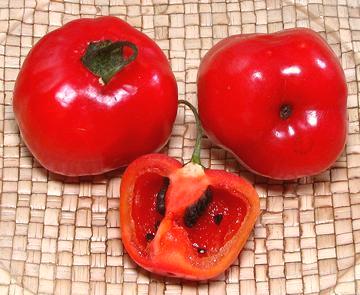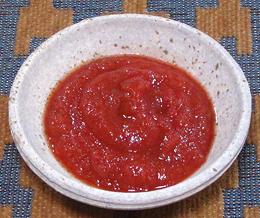 [Manzana, Canario (yellow ones), Peron (Mexico); Manzano, Chile de
Caballo, Qsacyol (Guatemala); C. pubescens]
[Manzana, Canario (yellow ones), Peron (Mexico); Manzano, Chile de
Caballo, Qsacyol (Guatemala); C. pubescens]
These two chilis are both of the same species, Capsicum
pubescens, varying mainly in color and region where grown. They
are popular in mountain regions because the plants can stand colder
temperatures than many chilis. Unless color or size is very important,
they can be interchanged in recipes. These chilis are fairly hot
(H8), but have more flavor than many
chilis in this heat range. They have fairly thick walls, so don't dry
well. The Manzana / Rocoto is the only widely cultivated species of
C. pubescens, and is the only common chili with black or dark
brown seeds.
.
 [Manzana, Canario (yellow ones), Peron (Mexico); Manzano, Chile de
Caballo, Qsacyol (Guatemala); C. pubescens]
[Manzana, Canario (yellow ones), Peron (Mexico); Manzano, Chile de
Caballo, Qsacyol (Guatemala); C. pubescens]
Native to southern Central America, these chilis have been cultivated for about 8000 years, and are now grown from California to Guatemala. The bush can live 15 years and grow as tall as 10 feet. Manzana chilis range from green to yellow and orange, round to bell shape and 1 to 2-1/2 inches diameter.
The orange ones in the photo are the most common variety in Southern California, but other colors can sometimes be had from farmer's markets. The photo specimens were purchased from a large Los Angeles (Burbank) market that specializes in Mexican, Central American and South American foods, but a few less specialized markets also have them. The largest was 2 inches diameter.
More on South American Chili
Peppers.
 [Rocoto, Locoto (Peru, Ecuador, Bolivia); C. pubescens]
[Rocoto, Locoto (Peru, Ecuador, Bolivia); C. pubescens]
Native to northwestern South America, these chilis have been cultivated for about 8000 years, and are now grown from Ecuador to Chile. The bush can live 15 years and grow as tall as 10 feet. Aji Rocoto are mostly red in South America, but can also be green to orange. They are round to bell shape and 1 to 3 inches diameter.
Aji Rocoto tend to be larger than the orange Manzanas, and in Peru are often stuffed like Bell Peppers are here. The photo specimens were purchased from a large market in Los Angeles (Burbank) that specializes in Mexican, Centeral and South American foods, mixed in with orange Manzanos. The largest was 2-1/2 inches diameter and 2-1/8 inches high, but I have purchased frozen ones from Peru up to 3 inches diameter.
More on South American Chili
Peppers.
 This product is very important
in Peru, and available in North America from specialty markets and
on-line. Because the only significant ingredients are Rocoto Chilis,
salt and citric acid, it can often be used in recipes calling for fresh
chilis. The photo specimen was purchased from a large market in
Los Angeles (Burbank) that specializes in Mexican, Central American and
South American foods. 2017 US $3.99 for an 8 ounce jar. Ingred:
Rocoto hot pepper, salt, citric acid, potassium sorbate.
This product is very important
in Peru, and available in North America from specialty markets and
on-line. Because the only significant ingredients are Rocoto Chilis,
salt and citric acid, it can often be used in recipes calling for fresh
chilis. The photo specimen was purchased from a large market in
Los Angeles (Burbank) that specializes in Mexican, Central American and
South American foods. 2017 US $3.99 for an 8 ounce jar. Ingred:
Rocoto hot pepper, salt, citric acid, potassium sorbate.
 [Locoto en Polvo, Chiles Picantes (Spanish); "Hot Spyccy Peppers" (English);
Capsicum pubescens]
[Locoto en Polvo, Chiles Picantes (Spanish); "Hot Spyccy Peppers" (English);
Capsicum pubescens]
This is one of the few forms of Hot Chili available in Argentina for folks
desiring some chili heat. They're usually from somewhere else, and so is this
chili powder. It's imported from Bolivia, and sold by verdularias (green
grocers), many of whom are from Bolivia.